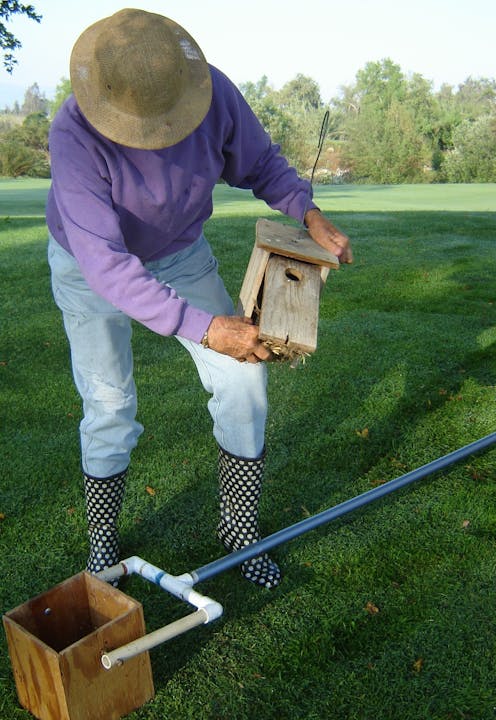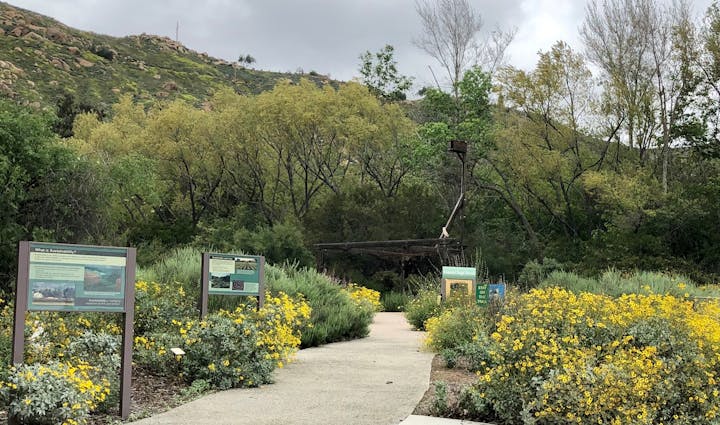Volunteer Opportunities
The Riverside-Corona Resource Conservation District (RCRCD) offers a variety of volunteer opportunities and welcomes your involvement in helping to conserve natural resources.
What volunteer opportunity interests you?
Sycamore Creek Interpretive Center Site Volunteer
SCIC volunteers assist with welcoming visitors to the Interpretive Center and helping with materials and programs/field trips. Occasional Fridays & Saturdays
Monarch Site Volunteer
Monarch habitat volunteers help plant, weed, and collect seed for Monarch butterfly habitat at RCRCD’s Greenbelt property in Riverside. Periodic Fridays & Saturdays
Monarch Monitoring Volunteer
Monitoring volunteers observe and report data about Monarch caterpillars and butterflies. Training is provided. Select dates, April through September
LandUse Learning Center (LLC) Site Volunteer
LLC volunteers assist with site management, such as gardening, fruit tree pruning, planting, weeding. Wednesday through Sunday opportunities.
LandUse Learning Center Docent
LLC docents greet and direct visitors, conduct tours, and assist with occasional field trips. Docent training is provided. Monday through Sunday opportunities.
Bluebird Nest Box Monitoring
Interested volunteers can borrow nest boxes from RCRCD to hang in trees for weekly monitoring. Training for hanging, monitoring, and reporting is provided. Bluebirds nest in cavities or holes in trees or other wooden structures. Providing nest boxes increases Western Bluebird populations. Weekly during nesting season, often February through July.
Want to get involved?
Please fill out our volunteer application and a project manager will contact you shortly.
Volunteer Waiver Form
All volunteers must sign a volunteer waiver form in order to participate in volunteer activities. Our current volunteer waiver in Word Doc or PDF form, can be downloaded below:
RCRCD - Generic Waiver for Volunteers.DOCXRCRCD - Generic Waiver for Volunteers.pdfAdditional Information:
Help Bring Back the Bluebird Population
Did you know that bluebirds nest in tree cavities? Unfortunately, many urban areas have few trees. We can provide cavities for bluebirds and other native birds by hanging nest boxes on trees in special urban locations, such as above irrigated lawns in parks, golf courses, and even cemeteries.
Each spring, the Riverside-Corona Resource Conservation District seeks volunteers to hang and monitor nest boxes. Volunteers hang and check boxes weekly from February through June. Each team or individual usually monitors between three to five boxes, which takes about one hour per week. The RCRCD matches volunteers to their closest nest box location to limit travel time.
Many Western Bluebirds fledge each year thanks to our local volunteers. Some other native birds also use a few of the nest boxes, including the Ash-throated flycatcher, who's numbers are in decline. The results of our monitoring studies are sent to a national data bank at Cornell University.
Additional sources of information about bluebirds:
The North American Bluebird Society(NABS) promotes the recovery of bluebirds and other native cavity-nesting birds.
California Bluebird Recovery Program is a great source of local information.
RCRCD Supporting Western Bluebirds Publication
The Bluebird Book, the Complete Guide to Attracting Bluebirds, by Donald and Lillian Stokes.
To contribute personal bluebird observations to a national data base, check out NestWatch at Cornell University School of Ornithology.
RCRCD Monarch Habitat
In Spring of 2020, the RCRCD received a grant from the Wildlife Conservation Board and the California Association of Resource Conservation Districts, to establish 2 acres of Monarch breeding and foraging habitat. In addition, funds were allocated towards community education on the plight and conservation efforts related to Western Monarchs.

Once millions of Monarch Butterflies would overwinter on the Pacific West Coast but their population has been on a drastic decline since the 1980's. In the winters of 2018 and 2019, just 30,000 monarchs were counted at overwintering sites. This drastic decline is due many factors including loss of habitat, pesticide use and climate change. With the population at just 1% of it's historic size, is is now critical to take the appropriate actions to support Monarch populations.

We have a long uphill battle to save the Monarch, but through community education and outreach, partnerships and conservation efforts, the RCRCD will continue to strengthen our endeavors. Despite the hurdles we faced with the Covid-19 pandemic, we have planted native milkweed and nectar plants at our 2 acre site in Riverside. This will be an on-going effort. It is our hope that not only will this provide critical foraging and breeding habitat to Monarch butterflies, but that it will be an educational resource for the entire community.
To learn more about what you can do to support the Western Monarch, visit the Xerces Society for Invertebrate Conservation and download a copy of our handout: Steps to Succees with Milkweed and Monarchs.
Upcoming Volunteer Events:
Monarch Moitoring:
Site weeding and planting:


